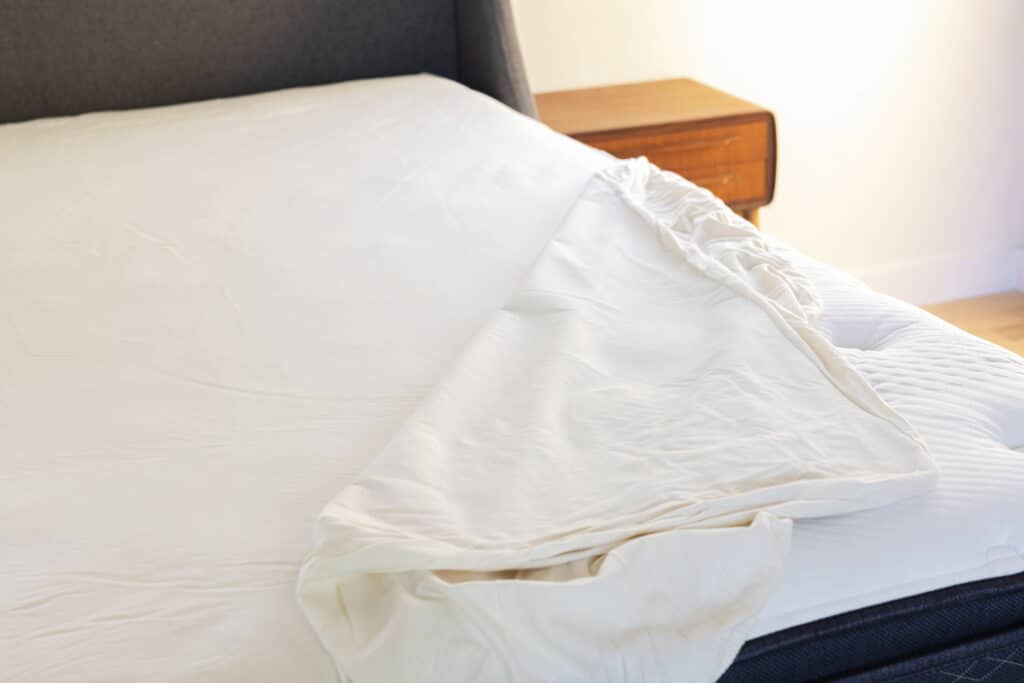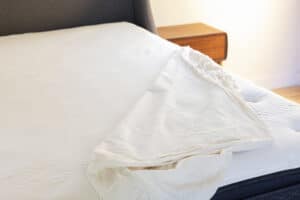Most conventional mattresses off-gas, harbor mildew and mold, and collect dust mites. Can an organic mattress cover make a foam mattress safer? Here’s the inside scoop on mattress wrapping to minimize VOCs and seal in bugs and bacteria.

Table of Contents
Why it matters: The trouble with foam mattresses
We discuss the problems with polyfoam more in depth here. For now, though, suffice it to say that foam mattresses are made with a slew of toxic chemicals, including volatile organic compounds (VOCs) such as:
- Styrene
- Benzene
- Toluene
- Formaldehyde
- Chemical flame retardants and stain repellents.
Many VOCs off-gas most when the mattress is new. Foam mattresses also off-gas in mid-life, however, and can start to off-gas more again as they get old and further degrade.
Even if you can no longer smell that new mattress smell, your mattress is likely still off-gassing some VOCs. Indeed, if you wrap a foam mattress effectively and then unwrap it after a few weeks, chances are you’ll be able to smell that ‘new’ mattress smell again!
If you can, prioritize non-toxic mattresses for the most vulnerable family members first. Remember that mattress dust and off-gassing affect indoor air quality throughout your home.
Given that it’s expensive to replace all your old foam mattresses with non-toxic, eco-friendly mattresses, it’s smart to find ways to minimize off-gassing and exposure to VOCs. This is where an effective mattress cover can help.
Can an organic mattress cover make a foam mattress safer?
Yes! An organic mattress cover can make a foam mattress safer, although it depends on the kind of cover, how you use it, and your priorities for safety.
Natural fabric mattress covers – pros and cons
Cotton, latex, and wool are great materials for organic mattresses and for protectors but are less effective at blocking off-gassing from a foam mattress.
This is because they are gas permeable (they let gases through), regardless of how tight the weave.
Some key points:
- Don’t assume a dust mite cover or mattress pad will block off-gassing. It almost certainly won’t
- Organic cotton mattress covers can block dust mites, bed bugs, and allergens, but not gases
- Organic latex and wool don’t block off-gassing from foam mattresses
- Plastic is the only current option for blocking off-gassing from foam.
If you’re less concerned about VOCs and more concerned about dust mites, bed bugs, and allergens, a tightly woven organic cotton mattress cover will be sufficient to improve safety.

Essential Mattress Protector
100% GOTS-certified cotton mattress protector. The Essential Mattress Protector has an earthy, natural feel. The fitted, lightweight pad is waterproof, machine-washable, and dependable in protecting your mattress from life’s little accidents.
Check that the cover is made with genuinely organic cotton (look for the GOTS label on the cover itself) and is free of toxic chemicals, TPU, PVC/vinyl, and polyurethane. Also, look for a mattress cover with pores no larger than about 5 microns. This means bed bugs, dust mites, and dust mite feces can’t easily get through the cover.
The best plastic mattress covers for off-gassing
As for off-gassing, the only current option for effective mattress wrapping is plastic, which isn’t an option most will want to deal with. Note, though, that a plastic mattress cover has to be made with specific kinds of plastic and be a certain thickness to prevent gas penetration.
Ironically, many plastic mattress covers actually add VOCs, instead of reducing overall exposure.
Mattress protectors made with vinyl or, more specifically, polyvinyl chloride (PVC) are notorious for off-gassing VOCs. They’re also noisy and can disturb sleep, and are made with phthalates.
Polyethylene is the best option for a plastic mattress cover to prevent off-gassing. Low-density, food-grade polyethylene (LDPE) or high-density polyethylene (HDPE) are two of the safest, least toxic types of plastic currently available.
LDPE is a simple plastic with few chemical additives and no phthalates or other plasticizers. Unlike HDPE, LDPE is also soft and flexible, which makes it useful as a mattress cover.
In New Zealand, specially formulated sheets of LDPE were developed by a physician and then tested and marketed as crib mattress covers under the BabeSafe brand. These effectively blocked off-gassing from crib mattresses.
The BabeSafe covers were made of 125 micron internally plasticized polyethylene (AKA polythene). This inert plastic doesn’t off-gas and is free of phthalates and bisphenol A.
Unfortunately, BabeSafe is no longer in business, although some other companies offer similar mattress wraps.
What about PLA, polypropylene, and TPU?
Other safer plastics for mattress covers include polylactic acid (PLA) and polypropylene. These, like LDPE, are made with very few chemicals of high concern compared to, say, polyethylene terephthalate (PET) or PVC.
PLA isn’t produced in large quantities, however, so you’re very unlikely to find it in a thickness suitable for mattress wrapping. Polypropylene is more widely produced and may actually last longer than a polyethylene cover, but I’m yet to find a mattress cover made with polypropylene.
Polyurethane mattress protectors are also very common. Unfortunately, though, these can add to off-gassing. After all, polyurethane is the material most mattresses are made of and is the primary source of VOCs you’re trying to block!
Some polyurethane covers are better than others, though, and there is a difference between a thin layer of PU and a blown PU foam that is made with a cocktail of added chemicals.
Full 360-degree mattress protectors that prevent off-gassing are few and far between. Finding one that’s also non-toxic and eco-friendly is a real challenge. That said, we found one!
Through our online store, LeafScore Essentials, we proudly offer a 100% GOTS-certified cotton mattress protector. This product is more effective for dust mites than off-gassing concerns.

Essential Mattress Protector
100% GOTS-certified cotton mattress protector. The Essential Mattress Protector has an earthy, natural feel. The fitted, lightweight pad is waterproof, machine-washable, and dependable in protecting your mattress from life’s little accidents.
Alternative mattress covers to prevent off-gassing
In the absence of ready-made mattress covers to prevent off-gassing, you might want to go the DIY route. Consider, for instance, using a mattress moving and storage bag.
One top choice is this robust mattress bag (view on Amazon) made with 6 mm thick polyethylene. It has a secure zipper closure and is meant for storage and to protect a mattress during a house move. However, there’s nothing to stop you from using it to wrap a foam mattress to prevent off-gassing. What’s more, it costs just $25 for a king-size bag!
Given the thickness of the plastic, I’d suggest wrapping the mattress in this bag and then adding a (plastic-free!) natural latex, wool, or cotton mattress topper for comfort and to minimize noise.
In a pinch, you might also consider wrapping your mattress in three 2 mm thick polyethylene moving bags from UHaul (view on UHaul). However, there’s a strong chance at least one of the bags will rip, and the plastic will likely be bulkier, noisier, and harder to handle than the single thicker bag above.
What else can I do about my mattress off-gassing?
Great question! Aside from replacing your mattress and using a mattress cover, you might also consider:
- Airing out any new foam mattresses in a well-ventilated area for two weeks
- Using an effective air purifier that traps VOCs
- Opening windows and doors whenever possible.
Don’t forget your foundation!
Foam mattresses aren’t the only part of most beds that off-gas VOCs. If you have a box spring or foundation made with synthetic materials, chances are that it also contains chemical flame retardants, glues, and formaldehyde in the particle board or manufactured plywood, and other materials and chemicals that off-gas.
A solid wood bed frame is the best non-toxic, eco-friendly choice as a foundation for your mattress. A metal bed frame is also a good option, though wood is easier to assemble time and again and to fix if a piece breaks or goes missing.
Ideally, your bed frame will be made from sustainably sourced hardwood grown locally and certified by the Forest Stewardship Council (FSC). It should be free of chemical stains or paints and treated only with heat and vegetable oils or other natural oils that don’t off-gas toxic VOCs.
We highly recommend the Avocado Green Foundation (view on Avocado). This is made with solid wood and GOTS organic cotton and is Greenguard Gold certified.
Naturepedic Organic Foundation (view on Naturepedic), made with organic cotton and American-grown hardwood, with no plywood or VOCs.
FAQs
In the absence of a well-made LDPE, PLA, or polypropylene mattress cover, some folks go the DIY route and make their own mattress cover using LDPE sheeting. This is often available at very low cost at hardware stores.
Be sure to find sheets that are at least 6 mm thick, however, to prevent off-gassing. And be very diligent about taping or tucking seams to seal in VOCs.
In years gone by, some enterprising folks purchased several BabeSafe crib mattress covers and then cut and taped these together to cover a larger mattress.
How well these DIY covers prevent off-gassing will depend on how effectively you manage to seal the plastic around the mattress. Note, too, that some plastic tape can also off-gas!
All plastics degrade, and they degrade faster when exposed to ultraviolet light, flexing (i.e., movement), moisture, heat, tears, and washing.
As plastic mattress covers degrade they’ll become less effective at blocking VOC off-gassing. This means it’s likely a good idea to replace a mattress cover every two or so years, or more frequently if the cover is damaged or shows serious wear and tear.